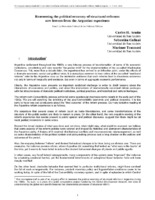| dc.description.abstract | By focusing in the Argentine case, the paper aims at answering why reform, who reforms and how reforms are made. It contains a synthesis of the politico-economic historical background that lead to reforms (why...); an analysis of the options, motivations and understanding that lay behind the strategic decision and design of the reforms (who...); and an explanation of the logic that characterized the implementation of reforms paying particular attention to, a) the way reforms were presented and legitimized vis a vis society and markets, b) the politico-institutional resources that made possible the reforms, and c) the political steering of the reforms by building coalitions and neutralizing the opposition within the complex realm of political and economic actors affected by the reform process (how...). To answer these questions the analysis includes a short explanation of the key role played in the Argentine case by the Convertibility monetary regime, stressing both its functional character for the feasibility of the reforms as well as the causes and meaning of the rigid constraints posed by this type of monetary regime to public policy makers. Although the conclusions are incomplete at this stage of the work, they will draw from the findings of the previous sections addressing both, those specific to the Argentine case as well as those overall conclusions relevant for the general understanding of the political economy of structural reforms, such as: a) Contrary to some naïve rendering of the political economy of reforms, the sustainability of reforms does not depend necessarily on the verification of their Pareto improving characteristics, but might also lie on political configurations in which the losers do not have the power to effectively mobilize for reversal. (That is, effective reforms are not just the solution to coordination games, but in some cases they are the resolution to contradictions of interest); b) Focus should move away from "universal policy recipes" towards helping the countries in finding their own best feasible paths towards development; c) This requires a more "flexible" approach to the economics of development (among other things dropping the obsession of finding the idea or simplification or decalogue), but also a better understanding of the polities; d) There are some deeper determinants of behavior and hence outcomes that "fly below the radar" of the type of recipes coming from Washington in the 1980s and 1990s; e) Even when speaking about "institutional reforms" and "second generation reforms", "Washington" recipes tend to be either just statements of good will, or attempts to introduce "technocratic fixes" to what are deeply "political" problems (example: attempts at reforming the civil service, at "modernizing Parliament", or the Judiciary); y f) Societies need to build intertemporal agreements and some forms of consensus that will make their policies (even though not everybody's favorite) reasonably credible, while flexible enough to accommodate changing circumstances and new information (learning). | |


